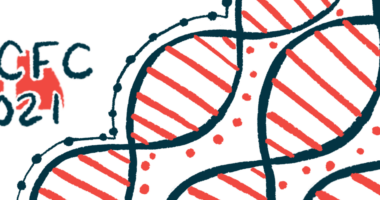Noninvasive Elastography Predicts Liver Scarring Severity in Children

A noninvasive imaging technique called elastography can detect the degree of liver fibrosis, or scarring, in children with cystic fibrosis (CF), according to a recent study.
Combining the technique with other laboratory tests in clinical practice might allow for the early diagnosis and treatment of liver disease in these patients, the researchers suggested.
“Elastography seems to be a noninvasive examination useful in everyday clinical work in detecting early liver changes and monitoring of progression in paediatric patients with diagnosed cystic fibrosis, ahead of changes in laboratory tests,” the research team wrote.
“The cost-effectiveness of this test, the possibility of its repetition, and its availability are additional benefits,” they added.
The study, “Assessment of Liver Fibrosis with the Use of Elastography in Paediatric Patients with Diagnosed Cystic Fibrosis,” was published in Disease Markers.
Lesions in the liver of CF patients can lead to serious complications, including fibrosis, cirrhosis — a late and severe stage of fibrosis — or portal hypertension, elevated blood pressure in the vein leading to the liver.
Liver abnormalities typically emerge in early life, but are often asymptomatic and difficult to capture in laboratory tests. This means that liver damage may not be detected until later in life, when it has already progressed significantly. New methods to detect early signs of liver fibrosis are needed to prevent serious complications from arising.
Dynamic elastography is a noninvasive imaging tool that measures the liver’s elasticity or stiffness. Since scar tissue buildup with worsening fibrosis typically makes the liver stiffer, elastography may be useful to monitor the degree of fibrosis in CF patients.
The research team evaluated whether the technique could detect the degree of fibrosis in the liver of 41 children (24 females) with CF at their clinic at the University of Silesia in Poland.
Upon physical examination, signs of CF-associated liver disease (CFLD) were observed in 16 children — seven boys and nine girls. Such signs, including enlarged liver or reduced flow of bile (a digestive fluid released from the liver), were detected with routine lab tests and abdominal ultrasounds.
Elastography was used to estimate the stage of liver fibrosis (from F0-F4) for each child, with a higher stage reflecting more significant liver stiffness and worse fibrosis. For example, F0 indicated no fibrosis, whereas F4 suggested cirrhosis was present.
Elastography findings were considered normal in 22 children (F0-F1), and abnormal in 19 children, five of whom were advanced (F3-F4). Children with higher elastography stages tended to have a significantly lower body mass index, likely reflecting malnutrition, the researchers noted.
Of the 16 children diagnosed with CFLD based on their physical exam, 12 had abnormal elastography findings. All five children with advanced elastography abnormalities (F3-4) had a CFLD diagnosis. Seven children who did not show signs of CFLD in other tests were considered to have abnormal elastography results.
The aminotransferase-to-platelet ratio index (APRI) and Fibrotest are two widely available indirect measures of liver fibrosis. Results of these two tests corresponded with observations from the elastography.
Specifically, seven children were considered to have abnormal APRI measurements, all of whom had CFLD. All five children with advanced elastography scores also had abnormal APRI measurements; the remaining two children with abnormal APRI had an elastography score of F2, indicating moderate fibrosis.
Ten children had abnormal Fibrotest results, eight of whom had CFLD. Similar to the observations with APRI, the researchers found that all children with advanced elastography changes had abnormal Fibrotest results.
While a comparison of elastography results to liver biopsies would be informative, the procedure is invasive and can be risky, and as a result, wasn’t performed in this study, the research team noted.
“In this study, we demonstrate the usefulness of combining transient elastography with APRI and Fibrotest to both confirm the presence of CFLD and differentiate early-moderate fibrosis from advanced severe fibrosis of the liver in paediatric patients with cystic fibrosis,” the researchers wrote.
They noted that they also plan to perform an elastography again in this group at five and 10 years in order to assess fibrosis progression.
“The detection of early lesions may in the future lead to earlier treatment and prevent the progression of the disease,” they concluded.








